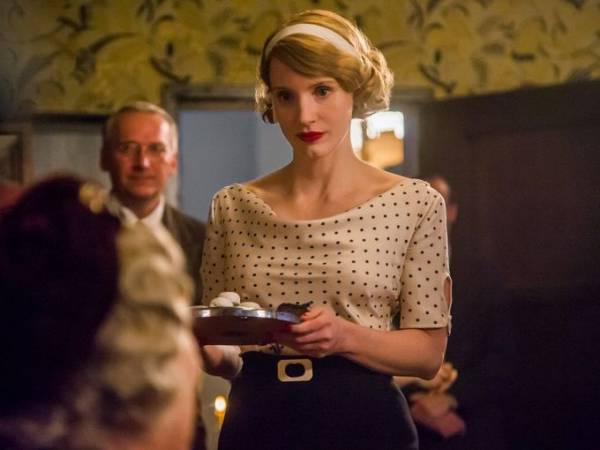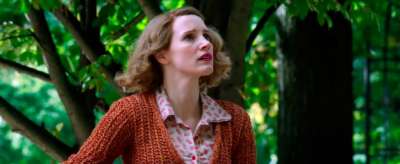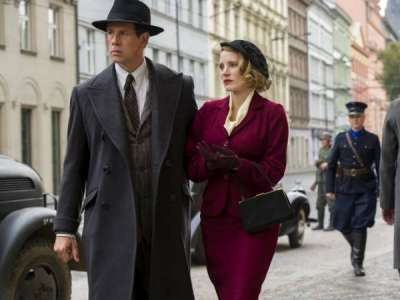
“The Zookeeper’s Wife” – a film review by Gary Chew
Three of the most powerful movies I can conjure up for the moment are Sophie’s Choice, Schindler’s List and The Pianist. Together, they took a total of eleven Oscars. Each informed film-goers — unable to recall what the Third Reich wrought in WWII — about the horrific evil of fascism. I can remember some of it, but these three films, particularly and hopefully, should be indelibly filed forevermore in the minds of younger men and women.
 Just imagine if you will though, that you’ve never seen such a film, and walk into a theater, sit down and watch the just released picture called The Zookeeper’s Wife. You’ll likely be blown away by the story. It’s based on real events that began in Warsaw, Poland in 1939… not so much a very good year for Europe.
Just imagine if you will though, that you’ve never seen such a film, and walk into a theater, sit down and watch the just released picture called The Zookeeper’s Wife. You’ll likely be blown away by the story. It’s based on real events that began in Warsaw, Poland in 1939… not so much a very good year for Europe.
As Jessica Chastain is one of the producers of the film, I’d like to suggest she has added her name to a remarkable roster of other actors for helping to sustain a vital cautionary narrative common in film. Among others, the list includes: Meryl Streep, Liam Neeson, Sir Ben Kingsley, Ralph Fiennes and Adrien Brody. Chastain, in the title role, plays Antonina Żabiński, a zookeeper’s wife and significant woman in history. (The screenplay comes from a book by Diane Ackerman who relied on journals written by Mrs. Żabiński.)
 Antonina was also a teacher and author of childrens’ books about animals. Her husband Jan (Flemish actor Johan Heldenbergh) was a zoologist and scientist. Jan founded the Warsaw Zoo and, together, the Żabińskis operated it with the help of dedicated employees.
Antonina was also a teacher and author of childrens’ books about animals. Her husband Jan (Flemish actor Johan Heldenbergh) was a zoologist and scientist. Jan founded the Warsaw Zoo and, together, the Żabińskis operated it with the help of dedicated employees.
Germany invades Poland in September of 1939, occupying the nation. Actor Michael Brühl plays the part of a German zoologist called Lutz Heck. He had met the Żabińskis at zoology conferences prior to Hitler’s push into Poland. As the Warsaw occupation gets underway, Heck shows up at their zoo as a sort of “nice” guy Nazi — having much already in common with Antonina and Jan. To some extent, Heck protects the pair because of similar interests and the knowledge they share about animals … as well as a strong but quietly held physical attraction he has for Antonina.
The Zookeeper’s Wife takes a similar path trod by Spielberg’s Schindler’s List. The Żabińskis, with the assistance of zoo employees, welcome the challenge of smuggling Jews out of Warsaw, using the trappings of the zoo and Jan’s access to those being detained in the Warsaw Ghetto. It’s quite amazing and pleasingly surreptitious to see the Żabińskis “pulling the wool,” so to speak, over the eyes of the German military. History indicates the Żabińskis kept about 300 Jews out of concentration camps.
Animal lovers will be taken with the regular appearance of the beautiful creatures inhabiting the zoo’s campus as well as Antonina and Jan’s home. Their love for the beasts is touching, especially when contrasted against the hostility of Hitler’s stranglehold on the people of Poland.
I recommend this PG-13 movie for youngsters, but not the really young ones. There is war violence and brief moments of erotic intention shown by Heck for Antonina, as well as other instances fueled by brutal German soldiers in combat zones. But the warmth and kindness shown for people and animals is a soothing balm for the rough spots that could prove to be an important learning experience for kids.
Prompted by contemporary social discord, The Zookeeper’s Wife is finding validation in a movie-goer’s regimen.

- Movie Review: ‘The Glorias’ - September 28, 2020
- Movie Review: ‘I’m Thinking of Ending Things’ - September 10, 2020
- Movie Review: ‘The Burnt Orange Heresy’ - August 31, 2020

